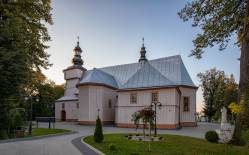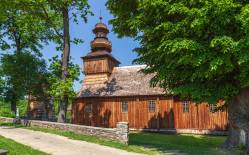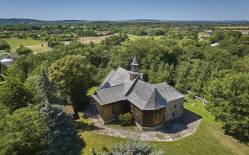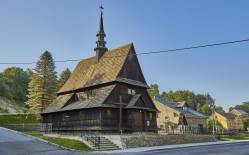If not for the numerous reconstructions and alterations, Church of St. Stanislaus the Bishop in Humniska would rank among the most special jewels of sacral architecture in the Podkaprackie, such as the churches in Haczów and Blizne. Even though it retains few signs of its ancient age it is worthy of attention, just like its “cousins” dating from the Middle Ages when many German settlements appeared in this region.
The church was built in the 1400s, and then in 1699 a brick sacristy was added. The structure was further remodelled a number of times between the 18th and 20th century. The new additions included the southern and the northern chapel as well as the vestibule. Apart from that, the nave was prolonged, the sacristy was reconstructed and the roofs were lowered and clad with sheet metal.
In 2002 a sensational discovery was made. It turned out that 15th century painted decorations of the roof beams were preserved along with Renaissance paintings on upper tie beams in the walls of transept annexes.
The log church, oriented towards the east, is a single span structure (the chancel and the nave are of the same width), with a rectangular floor plan, and a small transept as well as the side chapels. The chancel and the nave are covered with a ridge roof. On the ridge there is a weathercock with the date 1648.
Inside there are flat ceilings. The chancel entry is enclosed with a semi-circular arch, with rood beam supporting a Baroque crucifix. The furnishings mainly date from the 17th and 18th century. The mannerist high altar was brought here from a Capuchin church once standing on Michałek Hill in Blizne, after it was dismantled. Other features include four Baroque side altars, a Baroque pulpit, a stone Gothic baptismal font, and a stone holy water font from the 1500s.
Near the church we can see a brick zvonnitsa-type bell tower, with three bells, as well as a rectory.
The village of Humniska was owned by Zyndram from Maszkowice, who took part in the Battle of Grunwald. According to a local legend, a crypt underneath the church holds his mortal remains. However, Przysietnica and Brzozów also aspire to the title of the knight’s resting place
Photo: PROT
Gallery
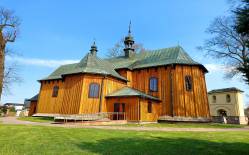
Recommended venues on the Trail



This website has been modernized with the financial support of the European Union under the Cross-Border Cooperation Programme Poland-Belarus-Ukraine 2014-2020. The responsibility for its content lies solely with the Podkarpackie Regional Tourism Board and cannot, in any case, be treated as a reflection of the position of the European Union, the Managing Authority, or the Joint Technical Secretariat of the Cross-Border Cooperation Programme Poland-Belarus-Ukraine 2014-2020.










